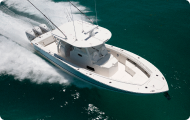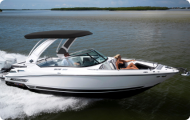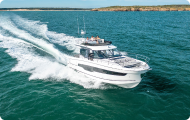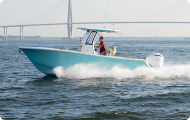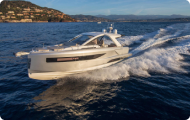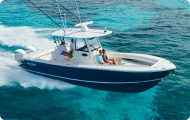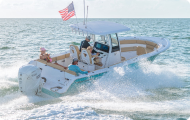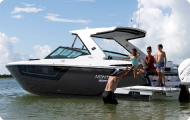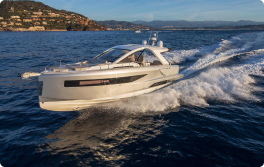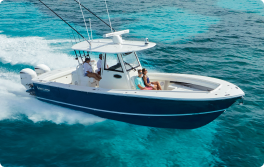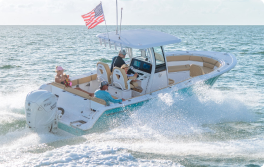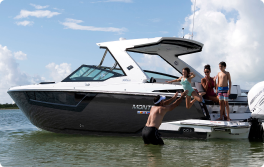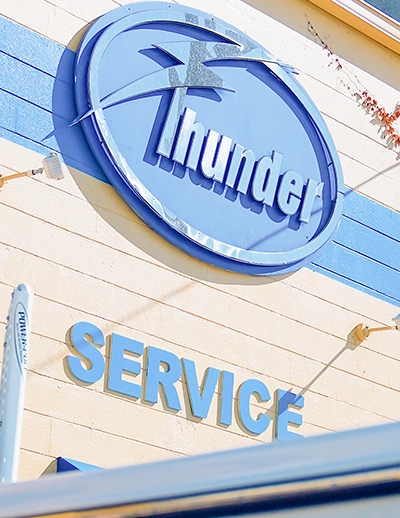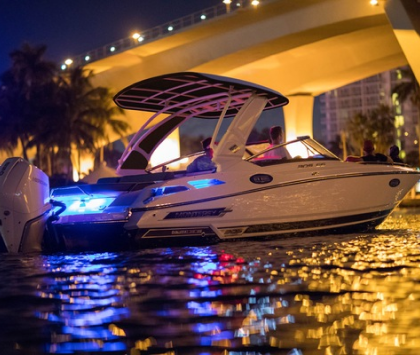How to set an anchor the right way
The proper technique for anchoring starts with easing the throttle so that the boat is basically standing still at the point where you want the anchor to drop. Let it go, sneak back under power, and slowly pay out the line.
You’ll need to know about how much scope to use since this will affect where the boat will lie once the hook is stuck. Experience and local knowledge of the bottom are the best teachers but plan on about an 8-to-1 ratio of scope to water depth. Meaning, in 10 feet of water with a 4-foot height to bow from the water, you stream out 122 feet of rode. With more chain and an oversized boat anchor, you may be able to ride reliably to a 4-to-1 scope, whereas poorly holding the bottom and/or strong wind and/or strong current may require a 10-to-1 scope. In some cases, tech gadgets can help you set the boat anchor.
At dead-slow speed, head the boat up into the wind or current, beyond the spot where you want the boat to lie, at a distance equal to your estimated scope. Come to a stop. In rough conditions, it can pay to drift back without dropping the boat anchor first, so that you can see where the boat will end up when you do deploy the hook.
4. Set It
When enough rode is out to equal the desired scope, snub up on the cleat. Allow the stretch to come out of the line and see if you are holding. A shot of reverse gear can often help set the anchor hook but, if done prematurely, can cause the boat anchor to skate across the bottom without catching.
When enough rode is out to equal the desired scope, snub up on the cleat. Allow the stretch to come out of the line and see if you are holding. A shot of reverse gear can often help set the anchor hook but, if done prematurely, can cause the boat anchor to skate across the bottom without catching.
With the hook set, cleat it off securely and run the rode through chocks to ensure that navigation lights and other deck equipment don’t get “swept” by the rode as the boat swings on the line. Line up with two landmarks, or use your radar, GPS or depth sounder to monitor your position and ensure that you are not dragging the anchor.
Your chart or plotter will generally show what to expect, but pockets of the unexpected do occasionally show up in an otherwise defined bottom to make life exciting. The most common bottoms are sand, mud, clay and grass (or weed). Most of the popular anchor styles (Danforth, CQR, Delta, Spade, Bruce, Rocna) are considered to be workable for all of these conditions. That said, plow anchors — like a CQR or Delta — hold best on a rocky bottom, a Danforth holds best in mud, and heavier anchors hold best in grass.
7. Size Does Matter
The boat anchor should be correctly sized for your boat. For instance, a typical 32-foot medium displacement boat could put out a 25-pound CQR or a 22-pound Delta and be comfortable in 30 knots of wind. A 12-pound Hi-Tensile Danforth is another option. One size up would be nice, especially if you have a power windlass to do all the work. Check the anchor manufacturer’s guide for your boat’s length, displacement and hull type.
The boat anchor should be correctly sized for your boat. For instance, a typical 32-foot medium displacement boat could put out a 25-pound CQR or a 22-pound Delta and be comfortable in 30 knots of wind. A 12-pound Hi-Tensile Danforth is another option. One size up would be nice, especially if you have a power windlass to do all the work. Check the anchor manufacturer’s guide for your boat’s length, displacement and hull type.
A properly sized all-nylon rode, either twisted or braided, is fine for light-duty anchoring. More common would be to add 6 to 8 feet of chain between the anchor shank and the rode. But for overnighting or extended anchoring, a one-half boat length’s worth of chain is a good rule of thumb to help an anchor’s holding power. The chain will aid in setting the anchor and keeping it set by lowering the angle of pull, thus helping to absorb the shock of a tossing boat due to wind or sea conditions and reducing chafe due to rocky or shelly bottom.
If you’re the first or only boat in the anchorage, you’ve got priority. Otherwise, choose your spot carefully so as to allow enough swinging room to stay clear of the others and show your anchoring etiquette.. Remember that big boats swing slower and tend to have a bigger arc than smaller ones. Boats with a lot of windage (big canvas enclosures, large cabins, high freeboard, and almost all sailboats) will swing faster in high winds.
Be sure to continue to check reference points, and watch to see that your position doesn’t change. Set the boat anchor alarm on your GPS, if yours has one, to alert you if something changes while you’re asleep or occupied. Then break out the sandwiches and enjoy the view.
The techniques in boat anchoring are the same, with or without a windlass. Keep in mind that a windlass is not a cleat and shouldn’t take the load of your boat under anchor. Neither is it the raw muscle to pull the anchor. Instead, take up the slack as you slowly motor forward to break the anchor free. Secure anchors hauled with windlasses with a trace of line or a chain stop.

